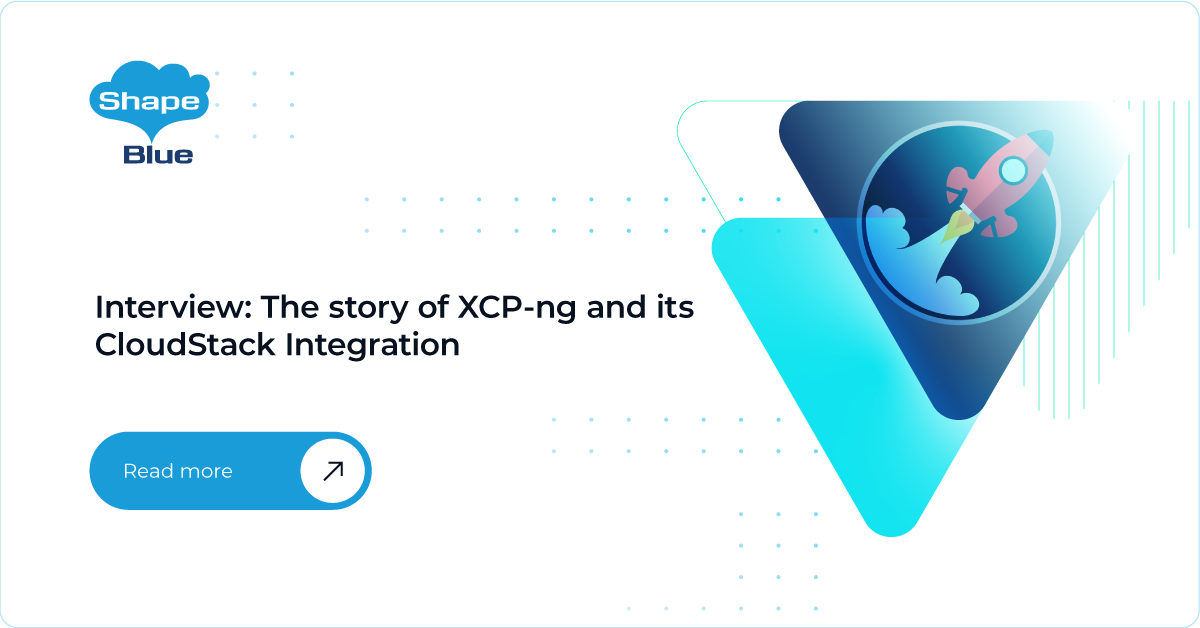XCP-ng is a high-performance enterprise-level virtualization platform backed up by an active open-source community. Based initially on XenServer it’s the result of cooperation between individuals and companies to build a product that can deliver powerful features with open-source freedom.
In this blog, we will meet Olivier Lambert and Marc Pezin, who will share the story of XCP-ng and how it integrates with CloudStack to deliver a turnkey solution for cloud, managed service providers and data centers.
 Olivier Lambert is the creator of Xen Orchestra and XCP-ng projects, also a Vates Co-Founder. He is focused on building a coherent, turnkey and fully Open-Source stack from the hypervisor to the management.
Olivier Lambert is the creator of Xen Orchestra and XCP-ng projects, also a Vates Co-Founder. He is focused on building a coherent, turnkey and fully Open-Source stack from the hypervisor to the management.
Get in touch with Olivier on LinkedIn
 Marc Pezin is working on the communication and business development of Xen Orchestra and XCP-ng virtualization platform. He is also a tech enthusiast and a fan of photography.
Marc Pezin is working on the communication and business development of Xen Orchestra and XCP-ng virtualization platform. He is also a tech enthusiast and a fan of photography.
Get in touch with Marc on LinkedIn
- Hello and welcome, Marc and Olivier. It is a great pleasure having you as a guest blogger. Can you share more about the story of XCP-ng? How did the project start, and what was the idea behind it?
Olivier: Originally, XCP-ng was a fork of Citrix Hypervisor. In 2018, Citrix changed its open-source policy, which pushed us to offer our Xen Orchestra users an alternative. The idea was to bring back from the dead the very old open source version of XenServer, XCP (Xen Cloud Platform), and so XCP-ng stands for Xen Cloud Platform – a new generation.
We didn’t go in blind either. We started with a Kickstarter campaign before publishing our virtualization platform. We had an unexpected success (collecting more than ten times the amount we targeted). Since 2018, the project grew a lot, and XCP-ng is now a project part of the Linux Foundation, under the banner of the Xen Project itself.
- How big is the team behind the project? Can you share more for the community of XCP-ng?
Olivier: Since 2018, our dedicated XCP-ng team has grown from 2 people to more than 10 experts (working full time on the project). We continue to grow with more and more innovative projects in the platform (e.g. making an XCP-ng port to RISC-V). We also won the innovation competition in France in 2019, allowing us to benefit from a boost from the French government for an amount of 1.2 million euros, to work mainly on innovation topics related to the platform’s cybersecurity.
Marc: On the community size, we have users and customers worldwide. We are close to 300 000 downloads of XCP-ng and thousands of contributors on the community forum. We have also partnered with a lot of companies to grow the XCP-ng ecosystem. We are working closely with software editors such as ShapeBlue or LINBIT but also integrator, hoster and even hardware provider (eg. Protectli in the US).

- What is the benefit of using open-source hypervisors?
Olivier: Open source is part of Vates’ DNA. In 2012 we were an open-source solution integrator and we are publishing open source solutions since 2015. For us, using an open-source solution is above all a matter of trust. XCP-ng is transparent. The code is auditable by everyone, same for managing security issues (eg. Meltdown or Spectre). Moreover, we do not lock our users in a system that they cannot easily leave because of a captive design or ecosystem.
Beyond trust, using an open-source solution also allows us to keep visibility on the roadmap of the editor, and, in our case, also allows us to offer greater flexibility to meet the specific needs of our users. To summarise, using an open-source solution avoids the opacity of proprietary vendors – complicated licensing models, costs that are difficult to control and quite high. With an Open Source solution, you keep both controls of your infrastructure and your IT budget.
- What type of companies can benefit the most out of XCP-ng?
Marc: We have a wide variety of users, and it is difficult to target a particular sector that could benefit from our platform. Any company building virtualization can be interested in our solution. The low costs of licensing are attractive for smaller organisations on a tight budget. On the other hand, larger organisations are attracted by the flexibility of our roadmap and the ability to meet specific needs.
One of the main advantages of XCP-ng is that it is a platform designed to meet the requirements of large and critical infrastructures but is accessible to all mid-sized and small organisations.
- Can you share more about the new LTS release of XCP-ng?
Olivier: XCP-ng 8.2 is our first LTS (long term support) release. This version mainly answers a recurring request from large companies with large infrastructures who want to limit the (major) updates they have to do in their infrastructure.
With this in mind, XCP-ng 8.2 will be maintained for around five years (a bit less now). On the other hand, to maintain the most stable version possible, which is the major concern of XCP-ng 8.2 LTS users, updates for this version will be limited to security fixes, major bugfix and some driver updates.
- How rapid is its development? What is on the roadmap?
Olivier: XCP-ng is a project in constant evolution and on several fronts at once. We are working on the platform’s security as part of the innovation contest and on a port to the new RISC-V open-source CPU architecture. We also have work in progress with external vendors like LINBIT (the main contributors to the DRBD project) to develop a hyperconverged solution compatible with XCP-ng. We have quite ambitious goals, so our team is constantly growing, especially on the development front. Of course, some of these projects are long-term. It is obvious that a port on RISC-V won’t be done in a snap.
Of course, apart from the major features and long-term projects, there is still a lot of work on the platform to offer more security, flexibility and performance.
- How does XCP-ng integrate with CloudStack?
Olivier: Since XCP-ng was originally a fork of Citrix XenServer, the integration of XCP-ng and CloudStack was not complex to do, which is a good thing. We partner with the ShapeBlue team to ensure everything works as expected, but it’s almost a formality because we share a common API with Citrix Hypervisor (Xen API).
XCP-ng 8.2 comes with a wide range of new capabilities including UEFI support, openflow controller access, native support for Gluster, ZFS, XFS, CephFS, new CPUs support and security improvements.
CloudStack has included support for XCP-ng since its early days. CloudStack 4.15.0 added support for XCP-ng 8.0 and 8.1, and the upcoming 4.15.1 will add support for XCP-ng 8.2 LTS. 4.15.1 will also add guest OS mappings for new and missing operating systems for XCP-ng 8.1 and 8.2.
Read the Success Story of IKOULA using XCP-ng and CloudStack
- What benefits does the combination of XCP-ng and CloudStack provide?
Olivier: The XCP-ng and Cloudstack combo is traditionally used in companies with large infrastructures. The power of CloudStack allows our virtualization platform to be more flexible and automate certain actions such as provisioning and lifecycle management of Virtual Machines, networks, Storage Repositories, templates, etc.
Marc: The fact that XCP-ng and CloudStack are both open source solutions also makes it easy to scale your infrastructure without any unpleasant surprises on the budget. Everything is transparent. Finally, subscribing to support for both XCP-ng and CloudStack allows you to completely cover your infrastructure, for each level of the stack. Both solutions are mature and stable and their usage can come with zero maintenance costs if you cover the management internally and great stability of the solution. At the same time, if companies would like to focus on their core activities and do not spend time on management, both XCP-ng and CloudStack have options for professional support.
Ivet Petrova is the Marketing Director of ShapeBlue. She is responsible for strengthening ShapeBlue’s global brand and market awareness of ShapeBlue’s services. Specifically, Ivet’s team is responsible for brand, advertising, content and digital marketing, social media, and media relations.
Ivet is also an active member of the CloudStack community, working on increasing the awareness of the technology and showing its benefits to a wider market.
Ivet has 13+ years of experience in marketing for IT service providers including a number of cloud and hosting providers, storage companies, SaaS providers and software development companies. She holds a Masters degree in Marketing.
Away from work, Ivet is passionate about travelling around the world and exploring new cultures.





